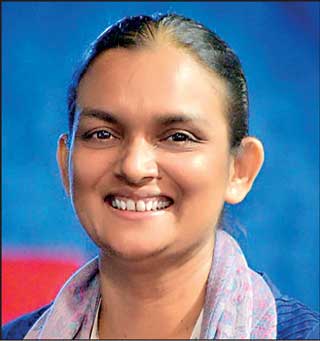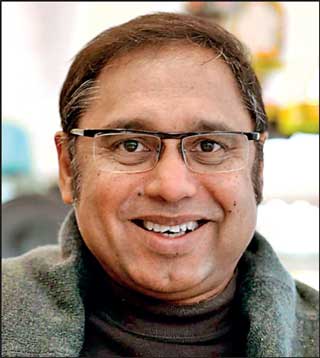Sunday Jan 18, 2026
Sunday Jan 18, 2026
Saturday, 17 February 2024 00:10 - - {{hitsCtrl.values.hits}}

 |
| Kamani Samarasinghe who spearheaded the follow up and coordination of the project |
 |
| Pulasthi Herath, the donor of the project |
By Surya Vishwa
A musical meet-up was held on 14 February (Wednesday) at the Vipulananda Institute of Aesthetic Studies in Batticaloa between its music/dance students and the students of ethnomusicology of the University of Visual and Performing Arts in Colombo.
The event which culminated in a joint performance of music and dance was facilitated through the sponsorship of a Sri Lankan-Australian dual citizen.
Pulasthi Herath had migrated to Australia in 1990 after graduating in engineering from Moratuwa University in 1985. He is today an Australia based civil engineer. His sponsoring facilitated for the Sinhala students to be transported to Batticaloa and engage in community interactions being based in the district for several days. To almost all of the Sinhala students it was a very first experience of visiting the east of Sri Lanka. The sponsorship allowed for a series of field visits to remote locations of the Batticaloa district to attend community performances of traditional/folk music and dance, facilitated with the cooperation and coordination of the Batticaloa district cultural officers attached to the Cultural Department of Sri Lanka.
In a brief telephone conversation with this writer, Pulasthi Herath stated that the sponsorship was made by him to signify his gratitude to Sri Lanka for the free education he received at the Moratuwa University and also to celebrate his lifetime passion for music which he had as a youth contemplated on making his fulltime profession.
On one of his recent annual visits to Sri Lanka he had informed his friend, the University of Visual and Performing Arts’ and the then Dean of the Faculty of Music at the University of the Visual and Performing Arts, Prof. Saman Panapitiya, that he is willing to fund any initiative of the university seeking to conserve and promote traditional folk/indigenous music of Sri Lankans.
Momentum to put this initial idea into practice was given by the Vice Chancellor of the University of Visual and Performing Arts, Prof. Rohan Nethsinghe, a musician, composer and community artist, who was previously affiliated with the Faculty of Education of the University of Canberra in Australia.
Kamani Samarasinghe, Senior Lecturer in IT at the Department of Information Technology who seeks to promote audio visual archiving had robustly taken on the task of carrying out the necessary follow up to make the project a success and is the main coordinator for the project.
Having several key objectives such as introducing Sinhala students to music of Eastern Sri Lankan Tamil tradition *(vice-versa) facilitating cultural exchange, setting an entrepreneurial foundation where possible to promote rural intangible heritage, the project has had village based visits since end last year and in February this year just prior to the joint performance between the arts students of Colombo and Batticaloa.
Thirty-five students of the Department of Ethnomusicology of the Faculty of Music of the University of Visual and Performing Arts in Colombo took part in the field visit and the grand music and dance performance at the conclusion of the musical meet up, under the guidance of the Head of Department of Ethnomusicology Nishoka Sandaruwan and senior lecturer in dance Lasantha Edirisinghe and supported by Harsha Jagoda, research assistant attached to the Archival Unit of the Ethnomusicology Department and final year student, Maduwanthi Priyaharshani who assisted in the Sinhala-Tamil translations.
Award winning violinist and Carnatic music instructor of the Department of South Indian Music, Thibaharan Shanmuganathan, alongside several other academics and senior students connected to disciplines such as dance, applied communication and audio visual technical support staff of the university played a central role in the practical implementation of the performance and connected events.
The program was facilitated from Batticaloa under the supervision of Prof. Florence Bharathy Kennedy, Director of the Swamy Vipulananda Institute of Aesthetic Studies and managed by a team led by senior lecturer, Department of Carnatic Music, Dr. Bharathy Prashanth and senior academic from the Department of Dance, Drama and Theatre, Dr. P. Jegatheeswaran who was the main coordinator for the project from SVIAS.
The event was attended by students and staff of almost all the sections of the Swamy Vipulananda Institute and the stage and event décor handled by the students of the Department of Visual Arts.
As in the case of the Sinhala students who had no chance to make Tamil friends, for many of the students of the institute who are from various locations of Sri Lanka, it was a first opportunity to meet up with the Sinhala students studying similar arts related subjects.
The Harmony page will carry a detailed coverage of the field visit and the two-day-long interactions/rehearsals and camaraderie that enabled the Sinhala music students to sing in Tamil and for the students of the Swamy Vipulananda Institute of Aesthetic Studies in Batticaloa to perform in Sinhala, adapting to the vocal style of the two traditions and learning the language pronunciation in a very short time span.
The main highlight was the joint performance between the ethnomusicology students attended to by key academic dignitaries which is to be followed up in a second joint performance in Colombo next month to coincide with the visit to the country by the project donor, Pulasthi Herath.
The event on 14 February at the Swamy Vipulananda Institute was held under the patronage of Eastern University Vice Chancellor Prof. B. Kanagasingam, University of Visual and Performing Arts in Colombo Vice Chancellor Prof. Rohan Nethsinghe, and iconic representative of Tamil culture and expert on performing arts, koothu/traditional drumming and Tamil historic literature who is current member of the Eastern University Board of Management, Professor Maunaguru. Top officials of the Police and Military attended on special invitation.
Both the Vice Chancellors of the Eastern University and the University of Visual and Performing Arts were emphatically vocal on the potential of the arts as well as scholarship being strategically used for national unity with Prof. Nethsinghe tracing the history of how Pulasthi Herath came to be the sole financial supporter of the event and extending his heartfelt gratitude to him.
“This is what we need in this country. We need citizens to exercise their responsibility in supporting the arts for creating understanding and harmony between communities,” stated Prof. Nethsinghe, emphasising that artistes are a special breed whose sensitivity should be sharpened to represent the heartbeat of humanity.
He explained that he returned during the economic crisis in Sri Lanka leaving his academic career in Australia in order to carry out his duty by the country he was born to which had provided him the core foundational education.
“It is the people of this country who paid for my education here. Hence I have a duty to reciprocate when it is needed.”
“Artistes are people who think out of set frames. As far as I am concerned this has been my attitude from a young age. We need creativity and aesthetics to solve much of the problems of this world.”
“We speak of reconciliation and peace. Whatever politicians say or do, it is upto the people to create unity.”
“I am not here to create bridges. We don’t need bridges, We need to break them in order to bond together as a nation,”
Prof. Nethsinghe stated that he hopes to support all similar future endeavours, highlighting also the need for innovative research through universities to be a connecting factor between communities.
Eastern University Vice Chancellor B. Kanagasingam called for consistent further collaborations, citing the importance of interaction between youth and highlighting the role of arts in enhancing this interaction.
“Let us organise more of such events and strengthen this country and restore it. I thank all those who facilitated this event. I consider such events unforgettable experiences for all of us,” he stated.
Guest of Honour, Prof. Maunaguru urged for the arts to be appreciated so that it is promoted and rural traditional music preserved within the human heart and thereby shared for future generations, bringing human beings closer together.
“This hall was full in the first segment of this event. Now at the end of it as I give this vote of thanks I find many spaces in the auditorium. Why is it? Why cannot we be less busy and spend more time to show our love, appreciation, respect and gratitude to art?”
“I am a product of the Peradeniya University and I know the value of appreciating each other’s art. See what beauty we saw today. The performances were technically perfect where the artistry is concerned. However the most beautiful thing was when we saw the Sinhala students sing in Tamil and the Tamil students perform in Sinhala. They had learnt from each other in the past two days as part of this project as I understand. See how wondrous that is.”
“Every young person must learn Sinhala and Tamil in Sri Lanka as this is the only way we can understand each other emotionally. It is not just about a language. It is about understanding each other’s feelings. English is not a language that originated here. We need not be overly dependent on English. I am talking of the two local languages used by Sri Lankans.”
The joint performance between the students of the University of Visual and Performing Arts in Colombo and the Swamy Vipulananda Institute of Aesthetic Studies featured folk music of the Sinhala and Tamil tradition such as daru nalawili (lullabies) and traditional sung poetry featuring village traditions, values and customs as well as respect to mother earth/sun and nature as a whole, applicable to both cultures. Traditional drumming from both traditions was also a highlight.
An exceptionally unique aspect was that in just one day of training the Sinhala and Tamil students, as both groups and solo performers, managed renditions of complicated tunes in perfect pitch as pertaining to the relevant culture with accurate pronunciation (having spent much fun time teaching each other) on the days structured for the shared learning and rehearsal.
In out next editions we hope to have two special editions on the student interactions/vocal trainings and the field visits on community music of Batticaloa such as the music and cultural traditions of the Batticaloa Burghers, Koothu and traditional drumming linked to spiritual/religious beliefs of different Tamil societal segments and especially the dying out music and cultural traditions which now have only few aged practitioners.
The pictorial of the joint performance held at the SVIAS, published here courtesy the official website of SVIAS-EUSL is self-explanatory on the rich cultural traditions Sri Lanka is gifted with, which were brought to life on stage.
The Harmony page was initiated five years ago in the Weekend FT to promote integrated knowledge, literature/translations, poetry, music, dance, spirituality and all forms of intangible heritage, for safeguarding all species of mother earth.
Having ushered in an activism based innovative brand of phenomenological media reportage we embarked last year on a series of writings as part of a broader mission to help the nation ideate to mainstream art and artistes into the national economy at a juncture when art and artistes rarely figure in the mainstream fora where economic revival is discussed.
Thereby we will be featuring in the following weeks detailed interviews with the key practitioners and promoters of music and dance that we met in our special coverage of this event.